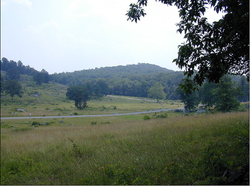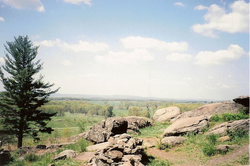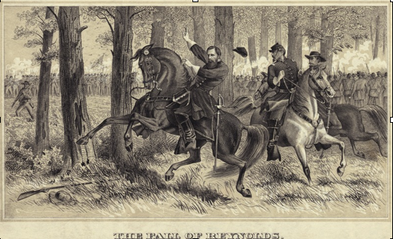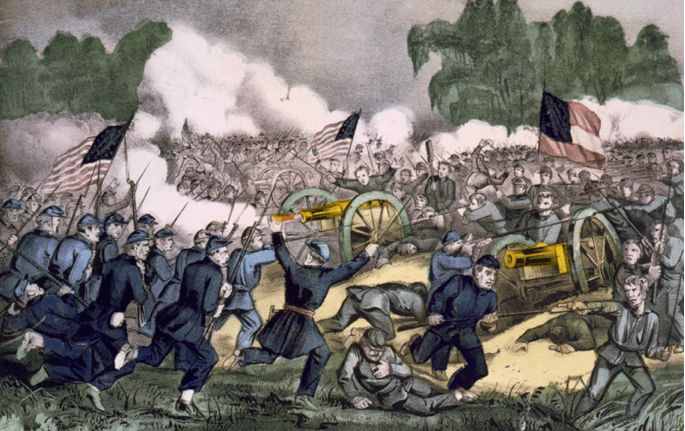The Battle of Gettysburg, Pennsylvania (July 1–July 3, 1863), was the largest battle of the American Civil War as well as the largest battle ever fought in North America, involving around 85,000 men in the Union’s Army of the Potomac under Major General George Gordon Meade and approximately 75,000 in the Confederacy’s Army of Northern Virginia, commanded by General Robert Edward Lee. On the morning of July 1, Major General Henry Heth, Hill’s Third Corps, sent his 7,500-man division down the Chambersburg Pike toward Gettysburg. Colonel John Buford had deployed part of two brigades of Union cavalry as a fight between small bodies of troops in the brush along Willoughby’s Run three miles west of town. Just two weeks previously, they’d been issued breech-loading a short rifle used in calvary, also know as carbines, and they used the guns to create the impression of a much larger force, slowing the advance of Hill’s brigades for a time before falling back. The Confederates followed them across the stream, only to meet a line of Union infantry on McPherson’s Ridge. The Army of the Potomac was arriving gradually, and among the first to arrive was a brigade of Western regiments that had earned the nickname “Iron Brigade of the West.” Confederates recognized these people and realized they were in for a rougher day than expected. By afternoon, Confederate reinforcements had also arrived, and the general engagement Lee hadn’t wanted at this stage of the campaign was a fait accompli. The Union’s XI Corps was driven back through the town of Gettysburg, losing 4,000 men, and by evening was entrenching on Culp’s and Cemetery hills south of town. Lee expressed a desire for General Ewell to assault the hills without waiting for further reinforcement, but he failed to make it an express order. Ewell did not press his tired men forward, giving Meade time to reinforce the troops on the hills.
Gettysburg Battle Summary
The battle was a turning point in the American Civil War. The defeat of the Confederate army led by Gen. Robert E. Lee by that of the Union, led by Maj. Gen. George Gordon Meade was a decisive factor in the civil war. The Confederates marched through Shenandoah Valley, after a successful confrontation at Chancellorsville. The aim was to reach Pennsylvania or Philadelphia, with the intent of furthering Confederate influence to Northern politicians.
Day 1: President Abraham Lincoln ordered Maj. Gen. Joseph Hooker to position his army in and around Gettysburg, ahead of Meade. The two armies clashed at Gettysburg on July 1, 1863. The Confederate fight back was effective in bringing down a cavalry division and quickly replenished Union lines. The Union army was forced to retreat to the hills, south of Gettysburg.
Day 2: On the second day, the Union held fast as the Confederate army raged through and attacked the fishhook defensive. Throughout the little town, heavy assaults at Little Round Top, Devil's Den, Wheatfield, Peach Orchard, Culp's Hill and Cemetery Hill raged, causing significant losses on either side. However, the Union personnel held their positions, strengthening resistance.
Day 3: On July 3, the battle commenced at Culp's Hill. The fronts were by now to the east and south of the town. The main event on Day 3 was the 12,500 infantry assault by the Confederates, on the concentrated Union line at Cemetery Ridge. The Confederate army suffered huge losses and retreated to Virginia.
Date(s): July 1-3, 1863
Principal Commanders: Maj. Gen. George G. Meade [US]; Gen. Robert E. Lee [CS]
Forces Engaged: 158,300 total (US 83,289; CS 75,054)
Estimated Casualties: 51,000 total (US 23,000; CS 28,000)
Description: Gen. Robert E. Lee concentrated his full strength against Maj. Gen. George G. Meade’s Army of the Potomac at the crossroads county seat of Gettysburg. On July 1, Confederate forces converged on the town from west and north, driving Union defenders back through the streets to Cemetery Hill. During the night, reinforcements arrived for both sides. On July 2, Lee attempted to envelop the Federals, first striking the Union left flank at the Peach Orchard, Wheatfield, Devil’s Den, and the Round Tops with Longstreet’s and Hill’s divisions, and then attacking the Union right at Culp’s and East Cemetery Hills with Ewell’s divisions. By evening, the Federals retained Little Round Top and had repulsed most of Ewell’s men. During the morning of July 3, the Confederate infantry were driven from their last toe-hold on Culp’s Hill. In the afternoon, after a preliminary artillery bombardment, Lee attacked the Union center on Cemetery Ridge. The Pickett-Pettigrew assault (more popularly, Pickett’s Charge) momentarily pierced the Union line but was driven back with severe casualties. Stuart’s cavalry attempted to gain the Union rear but was repulsed. On July 4, Lee began withdrawing his army toward Williamsport on the Potomac River. His train of wounded stretched more than fourteen miles.
Result(s): Union victory
The battle was a turning point in the American Civil War. The defeat of the Confederate army led by Gen. Robert E. Lee by that of the Union, led by Maj. Gen. George Gordon Meade was a decisive factor in the civil war. The Confederates marched through Shenandoah Valley, after a successful confrontation at Chancellorsville. The aim was to reach Pennsylvania or Philadelphia, with the intent of furthering Confederate influence to Northern politicians.
Day 1: President Abraham Lincoln ordered Maj. Gen. Joseph Hooker to position his army in and around Gettysburg, ahead of Meade. The two armies clashed at Gettysburg on July 1, 1863. The Confederate fight back was effective in bringing down a cavalry division and quickly replenished Union lines. The Union army was forced to retreat to the hills, south of Gettysburg.
Day 2: On the second day, the Union held fast as the Confederate army raged through and attacked the fishhook defensive. Throughout the little town, heavy assaults at Little Round Top, Devil's Den, Wheatfield, Peach Orchard, Culp's Hill and Cemetery Hill raged, causing significant losses on either side. However, the Union personnel held their positions, strengthening resistance.
Day 3: On July 3, the battle commenced at Culp's Hill. The fronts were by now to the east and south of the town. The main event on Day 3 was the 12,500 infantry assault by the Confederates, on the concentrated Union line at Cemetery Ridge. The Confederate army suffered huge losses and retreated to Virginia.
Date(s): July 1-3, 1863
Principal Commanders: Maj. Gen. George G. Meade [US]; Gen. Robert E. Lee [CS]
Forces Engaged: 158,300 total (US 83,289; CS 75,054)
Estimated Casualties: 51,000 total (US 23,000; CS 28,000)
Description: Gen. Robert E. Lee concentrated his full strength against Maj. Gen. George G. Meade’s Army of the Potomac at the crossroads county seat of Gettysburg. On July 1, Confederate forces converged on the town from west and north, driving Union defenders back through the streets to Cemetery Hill. During the night, reinforcements arrived for both sides. On July 2, Lee attempted to envelop the Federals, first striking the Union left flank at the Peach Orchard, Wheatfield, Devil’s Den, and the Round Tops with Longstreet’s and Hill’s divisions, and then attacking the Union right at Culp’s and East Cemetery Hills with Ewell’s divisions. By evening, the Federals retained Little Round Top and had repulsed most of Ewell’s men. During the morning of July 3, the Confederate infantry were driven from their last toe-hold on Culp’s Hill. In the afternoon, after a preliminary artillery bombardment, Lee attacked the Union center on Cemetery Ridge. The Pickett-Pettigrew assault (more popularly, Pickett’s Charge) momentarily pierced the Union line but was driven back with severe casualties. Stuart’s cavalry attempted to gain the Union rear but was repulsed. On July 4, Lee began withdrawing his army toward Williamsport on the Potomac River. His train of wounded stretched more than fourteen miles.
Result(s): Union victory

The view from Little Round Top overlooks Gettysburg's Valley of the Dead, where carnage of Civil War dead from both sides littered the landscape for more than a week following the battle.
Quotes
“FORWARD MEN, FORWARD, FOR GOD’S SAKE, AND DRIVE THOSE FELLOWS OUT OF THOSE WOODS.” "No Man Can Take Those Colors and Live"
“We may be annihilated, but we cannot be conquered.” General Albert Sidney Johnston, CSA, in accepting his command rank, August, 1861. “You ask me if I have confidence in the success of the Southern Confederacy? I pray for success but I do not expect success.” Senator Herschel V. Johnson of Georgia, prominent member of the Confederate Congress “The Lord spared the fitten and the rest he seen fitten to die.” Lincoln’s reference to growing up in Hardin County, Kentucky (now Larue County) “Sir, Mister, Be’ent you Jefferson Davis?” “Sir, that is my name.” “I thought so, you look so much like a Confederate postage stamp.” A North Carolina soldier to Jefferson Davis on the street in Richmond. “It is glorious to see such courage in one so young.” Lee, speaking of Major Pelham’s action at Fredericksburg.#
“My dead and wounded were nearly as great in number as those still on duty.”
— William C. Oates
“Up, men, and to your posts! Don’t forget today that you are from Old Virginia!”
— George E. Pickett
“The truth will be known in time.”
— James Longstreet
“In great deeds something abides. On great fields something stays. Forms change and pass; bodies disappear, but spirits linger, to consecrate ground for the vision-place of souls.”
— Joshua Lawrence Chamberlain
“After this urgent protest against entering into battle at Gettysburg according to instructions – which protest is the first and only one I ever made during my entire military career – I ordered my line to advance and make the assault.”
— John B. Hood
“FORWARD MEN, FORWARD, FOR GOD’S SAKE, AND DRIVE THOSE FELLOWS OUT OF THOSE WOODS.” "No Man Can Take Those Colors and Live"
“We may be annihilated, but we cannot be conquered.” General Albert Sidney Johnston, CSA, in accepting his command rank, August, 1861. “You ask me if I have confidence in the success of the Southern Confederacy? I pray for success but I do not expect success.” Senator Herschel V. Johnson of Georgia, prominent member of the Confederate Congress “The Lord spared the fitten and the rest he seen fitten to die.” Lincoln’s reference to growing up in Hardin County, Kentucky (now Larue County) “Sir, Mister, Be’ent you Jefferson Davis?” “Sir, that is my name.” “I thought so, you look so much like a Confederate postage stamp.” A North Carolina soldier to Jefferson Davis on the street in Richmond. “It is glorious to see such courage in one so young.” Lee, speaking of Major Pelham’s action at Fredericksburg.#
“My dead and wounded were nearly as great in number as those still on duty.”
— William C. Oates
“Up, men, and to your posts! Don’t forget today that you are from Old Virginia!”
— George E. Pickett
“The truth will be known in time.”
— James Longstreet
“In great deeds something abides. On great fields something stays. Forms change and pass; bodies disappear, but spirits linger, to consecrate ground for the vision-place of souls.”
— Joshua Lawrence Chamberlain
“After this urgent protest against entering into battle at Gettysburg according to instructions – which protest is the first and only one I ever made during my entire military career – I ordered my line to advance and make the assault.”
— John B. Hood

View from little round top. Location: Gettysburg, Adams County, Pennsylvania
Dates: July 2, 1863 Generals: Union: Major General Governeur K. Warren, Colonel Strong Vincent | Confederate: Brigadier General Evander Law, Colonel William Oates
Soldiers Engaged: Union Army: 3,000 | Confederate Army: 4,850
Important Events: Major General Gouverneur K. Warren, chief engineer of the Army of the Potomac, rushes troops to Little Round Top; they arrived minutes before the Confederates did. The 20th Maine Regiment charges late in the battle, foiling a flanking attempt by the 15th Alabama. Outcome: Union Victory Casualties: Union: 550 Confederate: 1,200
Dates: July 2, 1863 Generals: Union: Major General Governeur K. Warren, Colonel Strong Vincent | Confederate: Brigadier General Evander Law, Colonel William Oates
Soldiers Engaged: Union Army: 3,000 | Confederate Army: 4,850
Important Events: Major General Gouverneur K. Warren, chief engineer of the Army of the Potomac, rushes troops to Little Round Top; they arrived minutes before the Confederates did. The 20th Maine Regiment charges late in the battle, foiling a flanking attempt by the 15th Alabama. Outcome: Union Victory Casualties: Union: 550 Confederate: 1,200
<http://www.historynet.com/battle-of-gettysburg
<http://www.boerner.net/jboerner/?p=19379>
http://www.nps.gov/hps/abpp/battles/pa002.htm>
<http://www.army.mil/gettysburg/flash.html>
<http://honeymoons.about.com/od/pennsylvaniapoconos/ss/Gettysburg_4.htm>
<http://www.civilwar.org/battlefields/gettysburg.html>
<http://www.pccwrt.org/images/Famous_Quotes.htm>
<http://www.boerner.net/jboerner/?p=19379>
http://www.nps.gov/hps/abpp/battles/pa002.htm>
<http://www.army.mil/gettysburg/flash.html>
<http://honeymoons.about.com/od/pennsylvaniapoconos/ss/Gettysburg_4.htm>
<http://www.civilwar.org/battlefields/gettysburg.html>
<http://www.pccwrt.org/images/Famous_Quotes.htm>


